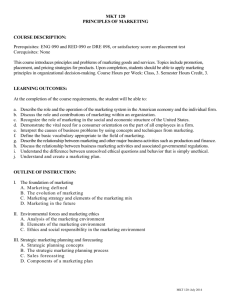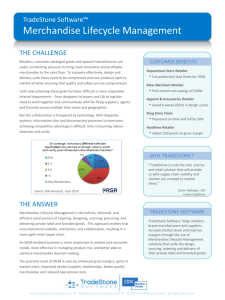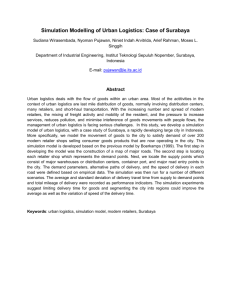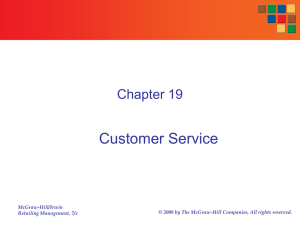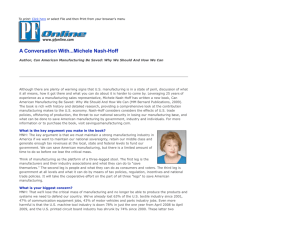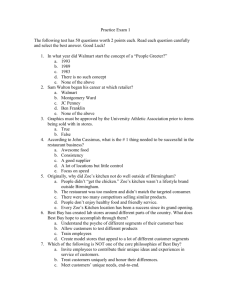nImportance of marketing
advertisement
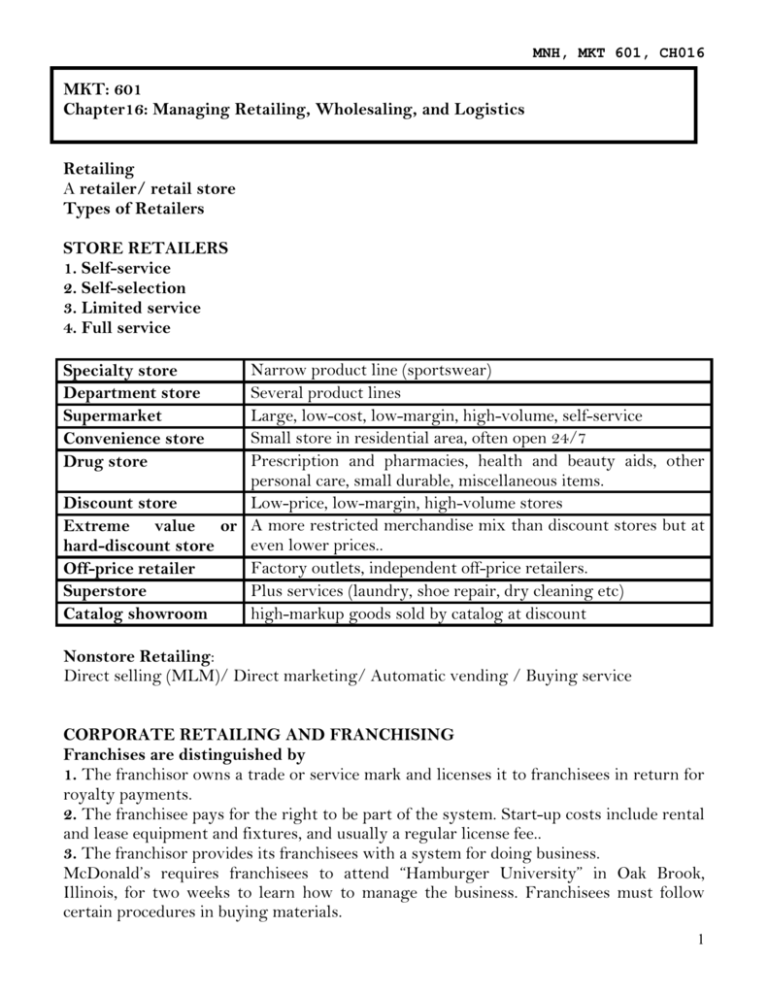
MNH, MKT 601, CH016 MKT: 601 Chapter16: Managing Retailing, Wholesaling, and Logistics Retailing A retailer/ retail store Types of Retailers STORE RETAILERS 1. Self-service 2. Self-selection 3. Limited service 4. Full service Narrow product line (sportswear) Several product lines Large, low-cost, low-margin, high-volume, self-service Small store in residential area, often open 24/7 Prescription and pharmacies, health and beauty aids, other personal care, small durable, miscellaneous items. Low-price, low-margin, high-volume stores Discount store Extreme value or A more restricted merchandise mix than discount stores but at even lower prices.. hard-discount store Factory outlets, independent off-price retailers. Off-price retailer Plus services (laundry, shoe repair, dry cleaning etc) Superstore high-markup goods sold by catalog at discount Catalog showroom Specialty store Department store Supermarket Convenience store Drug store Nonstore Retailing: Direct selling (MLM)/ Direct marketing/ Automatic vending / Buying service CORPORATE RETAILING AND FRANCHISING Franchises are distinguished by 1. The franchisor owns a trade or service mark and licenses it to franchisees in return for royalty payments. 2. The franchisee pays for the right to be part of the system. Start-up costs include rental and lease equipment and fixtures, and usually a regular license fee.. 3. The franchisor provides its franchisees with a system for doing business. McDonald’s requires franchisees to attend “Hamburger University” in Oak Brook, Illinois, for two weeks to learn how to manage the business. Franchisees must follow certain procedures in buying materials. 1 MNH, MKT 601, CH016 The New Retail Environment New Retail Forms and Combinations. Growth of intertype competition (Discount store, catalog showrooms also) Competition between store and non store based retailing Growth of giant retailer Decline of middle- market retailer Growing investment in technology Global profile of major retailer Growth of Shopper Marketing: POP display and explanation Marketing decision Target market Channels PRODUCT ASSORTMENT Product-differentiation strategy Feature exclusive national brands that are not available at competing retailers. might get exclusive rights to carry the dresses of a well-known international designer. Feature mostly private-label merchandise. Benetton and Gap design most of the clothes carried in their stores. Many supermarket and drug chains carry privatelabel merchandise. Feature blockbuster distinctive merchandise events Feature surprise or ever-changing merchandise. Off-price apparel retailer TJ Maxx offers surprise assortments of distress merchandise (goods the owner must sell immediately because it needs cash), overstocks, and closeouts, totaling 10,000 new items each week at prices 20 percent to 60 percent below department and specialty store regular prices. Feature the latest or newest merchandise first. Zara excels in and profits from being first-to market with appealing new look and designs. Offer merchandise-customizing services. Harrods of London will make customtailored suits, shirts, and ties for customers, in addition to ready-made menswear. Offer a highly targeted assortment. Lane Bryant carries goods for the larger woman. Brook stone offers unusual tools and gadgets for the person who wants to shop in a “toy store for grown-ups.” Procurement: direct product profitability (DPP) Prices High markup lower volume/Low markup higher volume 2 MNH, MKT 601, CH016 Services Prepurchase Postpurchase Ancillary Store Atmosphere (Walls, Lighting, Signage, Produce dept., Floors, Bakery) Store activities and experiences Communications Locations Retailers can place their stores in the following locations: Central business districts Regional shopping centers Community shopping centers. Shopping strips. A cluster of stores, usually in one long building, serving a neighborhood’s needs for groceries, hardware, laundry, shoe repair, and dry cleaning A location within a larger store locates new, smaller units as concession space within larger stores or operations, such as airports, schools, or department stores. Stand-alone stores avoiding malls and shopping centers to locate new stores in freestanding sites on streets, so they are not connected directly to other retail stores. Private Labels A private label brand (also called a reseller, store, house, or distributor brand) Role of Private Labels Private-Label Success Factors Wholesaling Selling and promoting Buying and assortment building Bulk breaking Warehousing Transportation Financing Risk bearing Market information Management services and counseling 3 MNH, MKT 601, CH016 Trends in Wholesaling Narus and Anderson interviewed leading industrial distributors and identified four ways they strengthened their relationships with manufacturers: 1. They sought a clear agreement with their manufacturers about their expected functions in the marketing channel. 2. They gained insight into the manufacturers’ requirements by visiting their plants and attending manufacturer association conventions and trade shows. 3. They fulfilled their commitments to the manufacturer by meeting the volume targets, paying bills promptly, and feeding back customer information to their manufacturers. 4. They identified and offered value-added services to help their suppliers Market Logistics Physical distribution has now been expanded into the broader concept of supply chain management (SCM). Market logistics planning has four steps: Deciding on the company's value proposition to its customers. What on-time delivery standard should be offered? What levels should be attained in ordering and billing accuracy? Deciding on the best channel design and network strategy for reaching the customers. Should the company serve customers directly or through intermediaries? What products should it source from which manufacturing facilities? How many warehouses should it maintain and where should they be located? Developing operational excellence in Sales forecasting/ warehouse management/transportation/materials Implementing the solution with the best information systems equipment, policies, and procedures. Integrated Logistics Systems The market logistics task calls for integrated logistics systems (ILS), involving materials management, material flow systems, and physical distribution, abetted by information technology (IT). 4 MNH, MKT 601, CH016 Market-Logistics Objectives Getting the right goods, to the right place at the right time for the least cost Each possible market-logistics system will lead to the following cost: M =T +FW+VW +S Where, M = total market-logistics cost of proposed system T-total freight cost of proposed system FW -total fixed warehouse cost of proposed system VW - total variable warehouse costs (including inventory) of proposed system S -total cost of lost sales due to average delivery delay under proposed system Market-Logistics Decisions Order processing (order to payment) Warehousing (Store WH, Distribution WH, Automated [techno based] Inventory: Order point(need to order)/Order processing costs/Inventory carrying cost Transportations Containerization consists of putting the goods in boxes or trailers that are easy to transfer between two transportation modes. Like, Piggyback describes the use of rail and trucks; fishy back, trainship, water and rail; air truck If the shipper owns its own truck or air fleet, it becomes a private carrier. A contract carrier is an independent organization selling transportation services to others on a contract basis. A common carrier provides services between predetermined points on a scheduled basis and is available to all shippers at standard rates. Organizational Lessons Companies should appoint a senior vice president should be accountable for logistical performance on both cost and customer satisfaction criteria. Should hold periodic meetings (weekly, biweekly) with sales and operations New software and systems is the key to achieving competitively superior logistics performance in the future. 5
